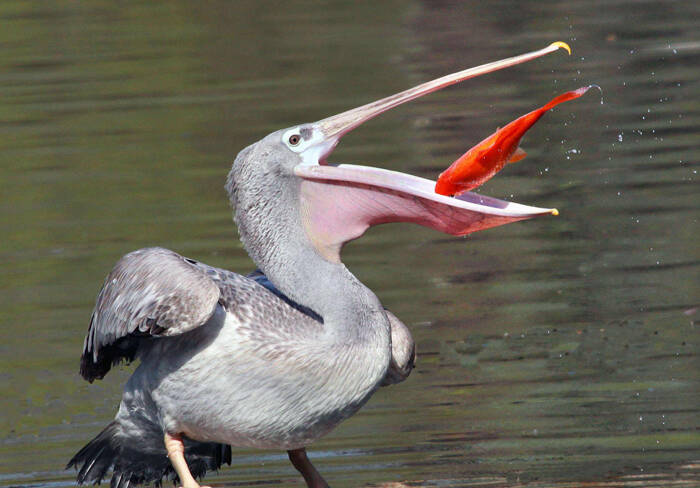Pelecanus philippensis
IUCN
LCBasic Information
Scientific classification
- name:Pelecanus philippensis
- Scientific Name:Pelecanus philippensis,Spot-billed Pelican,Pied-billed pelican, pelican, river escaping, goose, gannet, river escaping
- Outline:Waterfowl
- Family:pelican G.pelican
Vital signs
- length:134-156cm
- Weight:5kg and above
- lifetime:20-30years
Feature
The edges of the upper and lower mouth have a row of blue-black spots
Distribution and Habitat
Distributed in southern Asian countries such as Myanmar, India, Iran, Sri Lanka, and all the way to the Philippines and Indonesia.
In China, it is distributed in the lower reaches of the Yangtze River, Guangdong, Fujian, Yunnan, Taiwan, Hainan Island and other southeastern coastal areas.
Inhabits coastal coasts, rivers, lakes and swamps.
Appearance
The beak is long and thick, pink flesh color, with a row of blue-black spots on the edges of the upper and lower beaks, which is one of the differences between it and the Dalmatian pelican. The iris is white or light yellow with an inconspicuous brown. The color of the throat sac is also different from that of the white pelican and the Dalmatian pelican, it is purple, and the feet are dark brown. The feathers of the upper body in summer are light silver-gray, and the feathers on the back of the neck are light brown, long and fluffy, like horsehair, and extend further to the occipital to form a short crest. The flight feathers are mainly black, with lighter color at the tips. The feathers of the lower body are white, and the waist, flanks, anus and undertail coverts are decorated with grape red. In winter, the feathers of the head, neck and back are white; the waist, lower back, flanks and undertail coverts are also white, but the black feather shaft is exposed. The wings and tail feath
Details
Spot-billed Pelican, also known as Spot-billed Pelican, has two subspecies.

Spot-billed Pelican usually lives alone or in small groups. It is good at swimming and has strong flying ability. It flaps its wings slowly and powerfully, and often soars over the water. When swimming, the neck is stretched straight and the beak is tilted downward. It mainly feeds on fish, but also frogs, crustaceans, lizards, snakes, etc.
Spot-billed pelicans usually nest in groups. Usually nest in tall trees near lakes and swamps. The nest is quite large, made of branches and hay. Each nest lays 3-4 eggs, which are black-white and 81-83mm×47-58mm in size, with an average of 79mm×53mm. Males and females take turns incubating the eggs, and the incubation period is about 30 days. It is listed in China's "National Key Protected Wildlife List" (January 14, 1989).
Listed in the "Red List of Endangered Species of the World Conservation Union" (IUCN) 2018 ver 3.1-Near Threatened (NT).
Listed in China's "National Key Protected Wildlife List" (February 5, 2021) Level 1.
Protect wildlife and eliminate game.
Maintaining ecological balance is everyone's responsibility!








